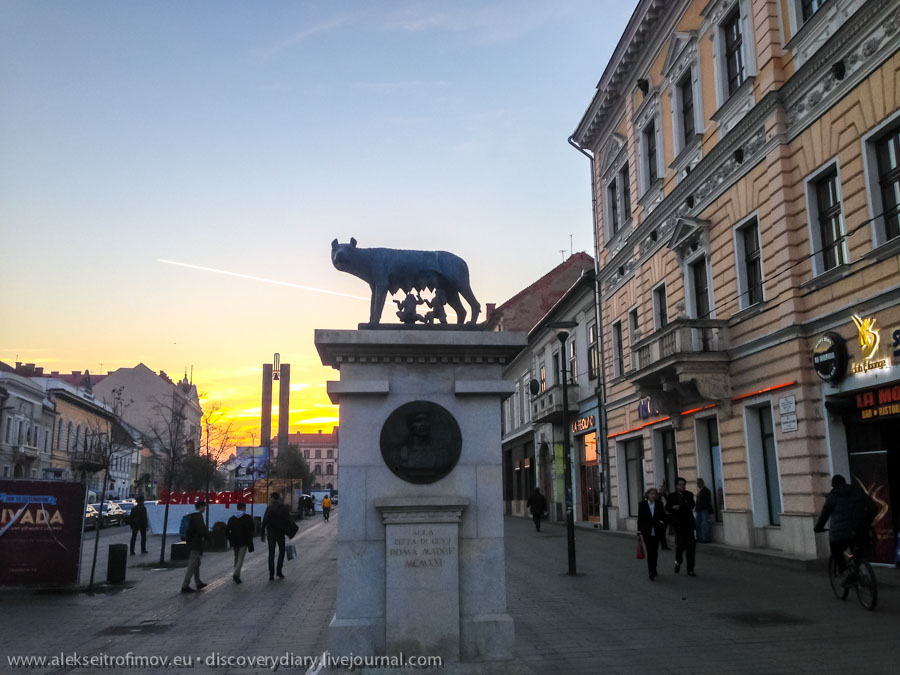From the feast of life called Seville, I departed for the Canary Islands. My photos from the Islands are still trapped on the flash memory card which was in the deceased photo camera. Thus I postpone the report on the Canaries until the time when I can liberate them. And so on to the next stage of my trip – Romania.
I first visited Romania only this summer – see my post about Bucharest here. This time around I was based in the second largest city in Romania, which is called Cluj-Napoca. It is the informal capital of the region of Transylvania.
If you look at the map of Romania, at first sight it looks like a coherent geographical unit. The political map though hides an important geographical reality – the Carpathian mountains, which act like a knife that cuts off from this single unit it’s North-Western slice. This slice is Transylvania.
The three major regions of Romania are Walachia, Moldavia and Transylvania. Unsurprisingly given the geography, historically they have never actually formed a political whole. They only ended up inside a single country after WWI, as the winners of the war imposed a harsh justice on the losers. This meant among many other things the break up of Austro-Hungary, which gave Transylvania to Romania. If the Romanianness of Walachia and Moldavia was never in doubt and these two principalities had periodically formed a political union, the destiny of Transylvania was always pointing towards Hungary. To this day this region has a large Hungarian minority and is strikingly different from the rest of Romania. As you would expect, the result is a rather heated argument between the Hungarians and the Romanians as to who was here first. The Hungarians would claim that when their ancestors arrived here in 10th century, the land was empty and the Romanians started settling here only later. The Romanian version is (naturally) the exact opposite.
Be it as it may, in the Middle Ages the Hungarian king decided that Transylvania was not sufficiently populated and issued an invitation to the inhabitants of his other possessions, mainly Germans, to settle here, accompanied with significant incentives. Consequently large numbers of Germans came to live here and a German culture flourished, leading to the creation of a fairytale-like land of Sievenbürgen – the Seven Towns of Transylvania, famous for their beauty and prosperity.
Cluj-Napoca plays an important role in all of these narratives. It is an ancient settlement founded by the Romans themselves – which is the reason it is held up by Romanians as the proof of their deep connection. Hungarians call the city Kolozsvár. Indeed even today it is easier from here to go to Budapest than to Bucharest. Finally the Germans call it Klausenberg – a jewel in the crown of Siebenbürgen.
The very name Cluj-Napoca is a paradox. Cluj comes from a Latin term meaning a closed castle. The old Roman castle was called Napoca. Thus in the 1970s Ceaușescu added the word Napoca to the familiar city name, in order to further establish its Romanian character. The resulting tautological hybrid in my mind sounds rather silly. It is an eternal reminder of the contested character of the place.
After WWII Hungarians formed 80% of Cluj’s population; today the proportion has reversed – 80% are Romanian. This was achieved by a massive infusion of Romanian population – Cluj grew four times during this time.
Cluj is paradoxical also in that it is almost like two cities in one. The whole topography of the place is divided into two. There are two Cathedrals: a Catholic one in the West (for Hungarians) and an Orthodox one in the East (for Romanians). The buildings and historical memorials grouped around each of the Cathedrals are correspondingly Hungarian and Romanian. The two clusters are in eternal opposition – even the wide boulevards connecting the two centres highlight this opposition. On one of such boulevards the Capitoline Shewolf is obviously meant to insist on the Roman(ian)ness of Cluj. A view from East to West:

Continue reading Cluj, the capital of Transylvania →